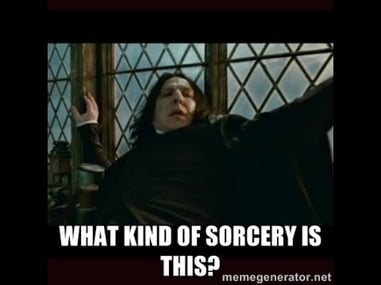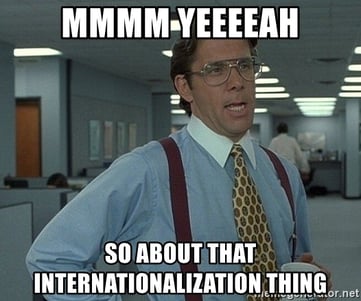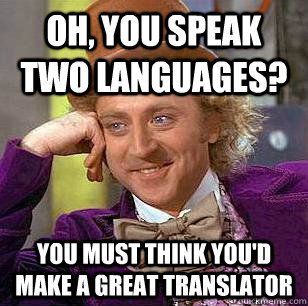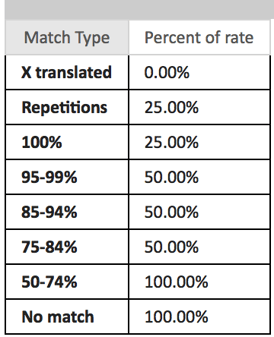%20(1)%20(1).png?width=740&name=concept%20of%20understanding%20i.e%20translation%20and%20localization%20(1)%20(1)%20(1).png)
Why are you here?
Is it because you’re considering or even planning to use translation to grow your business internationally and website localization is something that you’re curious about?
Or, is it because you’re looking to translate your product information, marketing content, technical documentation or any other content that is crucial to your business growth?
Regardless of the reason, this is the place where you will learn the basic terminology and what it means before you start working with a translation agency. Or translation freelancers. Or in-house translation team.
Whatever your path is, it’s good to know what you are getting yourself into.

Translation is not magic and it’s not just a craft - it is a service consisting of complex processes full of individual steps.
How much do you know about what translation is and how and if it differs from localization? How much do you know about the differences between localization and internationalization?
You might have heard of localization or transcreation. And let’s not forget internationalization and some more of the fancy language industry terms.
You might be asking yourself, why is it so important to know the language of localization professionals?
This article will give you a list with detailed explanation to these questions and then some more.
The first term that may be difficult to explain is localization itself. No, it doesn't have anything to do with Google Maps. It’s the process of adopting your product or content to a local market.
A successful product launch in the USA can be repeated in a different country with the proper localization solutions.
Going global means adopting your content or products to legal, technical, cultural and social requirements.
For example, taking a beer sold in so many different countries. MLDA (Minimum Legal Drinking Age) is a factor that needs to be taken into account.
MLDA varies worldwide. It is 21 years old in the USA, 18 in Australia and 16 in Italy. There are also countries like Qatar where drinking alcohol is prohibited.
This needs to be taken into account while preparing any marketing campaign. Not only will the text itself contain different information for various countries, but the graphics and videos need to address a target audience of appropriate age.
Localization professionals not only translate the words into local languages, like: French, Spanish, Chinese, Portuguese or Russian, but they also properly adopt your message for culture and social trends.
This knowledge and expertise is critical for worldwide marketing campaigns.
To summarize, localization is the process of making an impression that, from your buyers point of view, it seems like it’s been created especially for this market.
The ideal scenario is that even though something was created to serve global sales, it feels local for a diverse audience.

Internationalization is the process of creating the product or content in a way that it is free from localization obstacles. This goes into the product development itself, and starts before the product is ready.
Internationalization is the first step towards global sales.
For example, with software translation, it is crucial to factor in things like different time and date formats used in various countries. One aspect that needs to be taken into account is 24-hour vs 12-hour clock.
It is also crucial to know the local order of the numbers in dates, e.g.: May 3rd, 2018, can be written as 5-3-2018 but also as 3-5-2018. In order to avoid any confusion between May 3rd and March 5th, the format of the date needs to follow the local order.
An example of internationalization for programming translation, may be using the Unicode in order to avoid code corruption after translation. It is connected with local diacritics (a mark put above, below, through or on a letter).
Without this, special characters may not be displayed correctly in the localized content if they are not supported by the coding page used.
Internationalization is not only connected with IT localization or UI translation. It should also be taken into account while preparing global marketing campaigns.
Refraining from any reference to the culture and religion in the original text makes the content more localization-friendly.
Translation is one of the most commonly recognized parts of the localization process.
With regard to the ISO 17100 Standard for translation services, it is a set of processes to transfer content from one language into another in written form or other, like audio or images.
It has to be done by professional linguists who are also experts in the content’s subject matter.

Translation used to be associated with a linguist working with a dictionary and a typewriter. This romantic image has actually nothing to do with the way that contemporary professional translators work.
Typewriters and books have been replaced with professional translation software.
With regard to the translators, we may divide them into two categories: freelance translator and in-house translator. Both meet the standards of a professional translator.
The difference is in the way they work. Freelance translators decide which projects they take and when and where they work.
Translators employed by translation agencies have less freedom to dictate the amount and the type of text they work with. The translation teams, no matter if in-house or remote, are managed by localization project managers.
Professional localization companies tend to cooperate with freelance translators. It gives better flexibility due to the wider pool of subject matter professionals.
Referring back to the ISO 17100:2015 standard, the step following the translation phase is the revision stage.
The revision step is a bilingual examination of the target text against the content in the original language.
Revision is often referred to as a bilingual check. It is performed by a second linguist that’s proficient in the subject area. The revision stage is often included in the translation rate provided on proposals as TR (translation and revision).
You’ll want to make sure that you know if revision is included in every proposal that you get so you’re not stuck with extra costs.
Many people don’t perceive translation as a set of processes. Surprisingly, translation is a complex system. It is a set of interrelated and dependent activities.
According to the ISO 17100:2015, the translation service should include at least translation and revision.
But it can also be accompanied by additional stages like:
The translation process is much more than just a regular translation step. It is everything that precedes and follows the single act of translation.
This could be file preparation, quality assurance, review, consistency checks or linguistic testing. The process involves various professionals that make up big localization teams. Therefore, the translation process requires project management.
The actual translation is assisted by an advanced translation software called CAT (Computer Assisted Translation) tools.
There are all sorts of various CAT tools available on the market. You can choose from a web-based software, desktop solutions or a mixture of both. There are even versions for smartphones available.
All of the tools are very similar and serve the same main purpose - they speed up the translation process.
The most basic feature of all of the CAT tools is that they divide the content in the original language into logical chunks called segments and create a bilingual file.
The file is a two-column table with source language text on the left and an empty space - waiting for the translated content, on the right.
CAT tools create .xliff (XML Localization Interchange File Format) files that can easily convert back to the original file format and replace the source language content with the translated text.
The tools are very advanced and can be integrated with other tools and systems.
Related content: 50+ Translation Integrations with Your Backend that You Should Know About
CAT tools contain quality assurance modules, reporting options and many other features that speed up the translation process and help maintain quality. The sole act of translation is, however, still conducted by a human translator.
Computer Assisted Translation does not mean translations are actually made by a computer.
One of the other very important features of CAT tools is the database that stores all the translated segments.
This database is called TM (Translation Memory) and is one of the best inventions of the localization industry, for translation agencies and you.
Everything that has been translated in a document or a project is immediately saved in the TM and can be easily reused at any time.
For example, if your text contains two sentences that only have a single different word, the TM will immediately recognize the already translated sentence and point to the only one difference that needs translation.
Translation Memory saves a lot of time during the translation process and increases consistency.
Being consistent is very important so that you don’t confuse the reader or user. Imagine the name of a software option being different in the UI (User Interface) and in the IFU (Instruction For Use). This may lead to the necessity of costly last-minute updates.
Your reputation as a trustful professional may suffer from this localization error.
Now imagine a situation when you need a 100 pages of text translated without this help. You could accidentally translate similar sentences in different ways. You’d also end up manually translating text that you’ve already translated before.
Translation memory is inevitably an asset and it is important to remember about TM maintenance for the sake of consistency, creativeness and savings. The majority of translation companies provide such services.
The already mentioned savings that come from the TM are often called CAT savings.
The whole content, before it’s analyzed by the CAT tool, is referred to as the total word count.
On the other hand, when you account for any duplicated pieces of text together with the brand-new words, this gives you the weighted word count.
The most commonly used translation pricing is based on each word translated, on a per word basis.
Whenever you assign a document for translation, everything is saved in your TM. This stored translation stays with the translation agency, as a part of their CAT tool system.
If you work with a professional and honest localization company, they will use your TM matches to lower your translation cost. Basically, they won’t make you pay to translate the same paragraphs twice.
Whenever you are back with an update or a new content for translation, the first thing that should be done is an analysis of the text against your TM.
The report will include the amount of:
The tool then calculates the expected translation effort and provides the weighted word count.
Consequently, you will pay less for the weighted word count than for the total word count.
The chart below, called CAT grid, shows respective percentage of rate that you’ll pay depending on the type of matches in your content and on the number of repeated segments.

Language locale, also referred to as a language variant, like British and American English, for example, are the best examples to show the differences within one language.
There are a lot of examples of pairs or even groups that speak the same language in different ways. For example, French, which could be spoken in France or in Canada. Also, Spanish used in Spain and in Mexico.
Translating into a different locale requires hiring a different linguist. It will also call for a different cultural and social background to be taken into account.
Therefore, language locale matters a lot.
Whenever you ask for translation into Chinese and hear the question about the language variant, be sure you are talking with a professional.
Of course, you do not need to know offhand which locale to choose, as long as you can provide information on where your target audience is located.
A professional localization company will guide you through the language variants.
Transcreation is the highest level of marketing translation. It's the form of translation closest to copywriting, and naturally the most expensive. Whenever you are launching a new product, you need a professionally localized marketing campaign.
Transcreation is very often based on recreating the original text in the target language. The text still needs to be appropriate in the context for which it is intended.
Linguists who work on transcreation projects, must understand your desired outcomes thoroughly. You need to provide them with the full context and rich reference material.
The work of transcreation experts is based on a sort of artistic freedom. It enables the linguists to translate the meaning but allows significant changes in words and concepts.
It is very often applied to short content, like slogans. This is never a word for word translation and should be avoided as such.
Transcreation is usually charged per hour. As in copywriting, working on a few creative high visibility phrases takes much more time than a simple translation of a few words’ sentence in a longer text.
Whenever you start a new endeavor, no matter what subject area, learning the vocabulary is one of the most important aspects.
Knowing the localization terminology will help you understand, sometimes very complex translation proposals. Also, it will be much easier to be on the same page with localization project managers which will speed the translation process up.
When you know the basics of translation and localization industry, you will know:
Now that you know more about the terminology related to the translation and localization industry, you might start wondering about how much translation costs, what the benefits of using translation services are or which localization service will be the most suitable for your content.
Recommended articles:
15 Languages for Translation in 2020 that You Should Know About
Why Translation Integration with Your System Should Matter to You
+1 857 777 5741 ext. 203 (business inquiries)
+1 857 777 5741 ext. 205 (career inquiries)
Trylinskiego 16, 10-683
Olsztyn, Poland
Copyright ATL 2025. All Rights Reserved.